bigtrevs98
Harmless

Posts: 35
Registered: 14-4-2015
Member Is Offline
Mood: No Mood
|
|
Copper acetate and acetone?
So I have a solution of copper acetate and water. I put 50 mL of acetone and 10 mL of Copper acetate solution into a container. The copper acetate
goes from see-through to a dense looking whitish liquid..Also around the top of the clear liquid there seems to be a rapid precipitation of water or
something. What happened to the copper acetate?
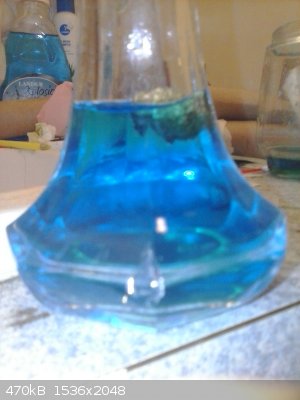 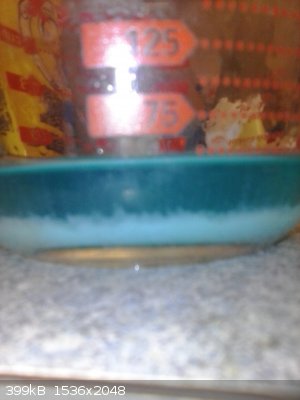 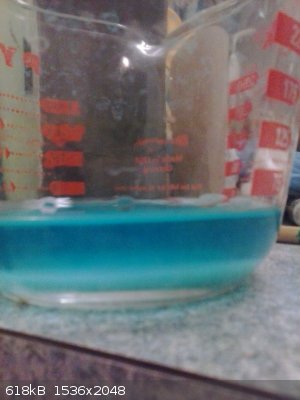
So I collected some of the precipitating clear liquid on the cup. Its acetone I think. It smells/burns like acetone. But it precipitates a lot
quicker than when I first made the solution
[Edited on 4-5-2015 by bigtrevs98]
|
|
|
violet sin
International Hazard
    
Posts: 1475
Registered: 2-9-2012
Location: Daydreaming of uraninite...
Member Is Offline
Mood: Good
|
|
Copper(I) acetate perhaps? Found this after googling copper acetate solubility in acetone.
-- https://books.google.com/books?id=Zk0z22smWUoC&pg=PA80&a... ---
Handbook of copper compounds and applications
"Made by Reducing an ammonia solution of copper (II) acetate. on acidification, white crystals of copper (I) acetate precipitates"
*edited for wrong name of book,... lack of sleep
[Edited on 4-5-2015 by violet sin]
|
|
|
bigtrevs98
Harmless

Posts: 35
Registered: 14-4-2015
Member Is Offline
Mood: No Mood
|
|
Just a little update. The whitish substance seems to be getting smaller and smaller. And could someone explain the difference and uses between the
two? (Copper(ii) acetate and copper(I) acetate)
[Edited on 4-5-2015 by bigtrevs98]
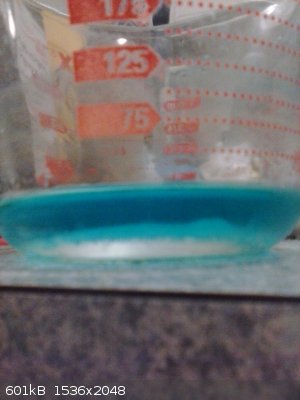
|
|
|
blogfast25
International Hazard
    
Posts: 10562
Registered: 3-2-2008
Location: Neverland
Member Is Offline
Mood: No Mood
|
|
So where's the reducing agent, violet sin? Oxidising acetone in these conditions is nigh impossible.
Acc. your own source Cu(II) acetate is only poorly soluble in acetone. Most likely then the acetone acted as an anti-solvent, precipitating the Cu(II)
acetate.
That some of the Cu(II) acetate seems to have re-dissolved could be due to better mixing of the water and the acetone.
|
|
|
DrMario
Hazard to Others
  
Posts: 332
Registered: 22-9-2014
Member Is Offline
Mood: Underpaid.
|
|
I'll try to reproduce this. I have a tiny amount of cupric acetate that I could partially sacrifice for the sake of science.
EDIT: I used a very diluted solution of cupric acetate in water. Added an equivalent volume of acetone, and indeed, I see the liquid becoming slightly
opaque.
I might try with a more concentrated solution later. Too bad I have so little cupric acetate.
[Edited on 4-5-2015 by DrMario]
|
|
|
Pumukli
National Hazard
   
Posts: 686
Registered: 2-3-2014
Location: EU
Member Is Offline
Mood: No Mood
|
|
You mixed copper acetate SOLUTION with acetone, so the starting material surely contained water. Copper(2+) ions in water have a nice blue color. When
you mixed this blue solution with acetone (which is almost free from water if pure) the acetone acted as an "anti solvent" as blogfast said, because
the solubility of copper acetate in aceton is much lower than in water I bet.
Aceton sort of "dehydrated" the previously water solvated copper (and acetate) ions and due to the poor solubility in that solvent solid, whiteish,
copper acetate fall out from the solution.
It was white, because the crystals were grown in a low water content environment (fairly concentrated acetone). I think anhydrous copper acetate has a
very faint blue color, or straight white, similarly to anhydrous copper sulfate.
Later part of the precipitate redissolved probably because of thorough mixing of acetone and water - as blogfast wrote.
|
|
|
MKSStal
Harmless

Posts: 21
Registered: 4-5-2015
Member Is Offline
Mood: No Mood
|
|
Adding acetone or some similar organic solvent is a popular way to participate some ionic, water solluble salt. Some time ago i used that to
participate lead(II) acetate from its water solution by adding isopropyl alcohol. Firstly i thought I had achieved my goal- white, crystalline mass
was on the bottom. However after filtering and drying it my yield was maybe about 60% (really not remember). Also after adding KI solution to filtered
solution much of yellow lead iodide was formed. As Cu(AcO)2 is quite similar to Pb(AcO)2 the same think was done by You. A participate is copper
acetate and due to its not too bad solubility in acetone/ water mixture some of it is still in solution making it blue. In my case solution was
colourless as lead acetate water solution is. In my opinion its caused by similarity between acetate ions and simple organic solvants. In your case
[CH3CO]O- and [CH3CO]CH3. Of course salts are ionic so the solubility is limited.
|
|
|
violet sin
International Hazard
    
Posts: 1475
Registered: 2-9-2012
Location: Daydreaming of uraninite...
Member Is Offline
Mood: Good
|
|
"So where's the reducing agent, violet sin? Oxidising acetone in these conditions is nigh impossible.
Acc. your own source Cu(II) acetate is only poorly soluble in acetone. Most likely then the acetone acted as an anti-solvent, precipitating the Cu(II)
acetate."
@ blogfast25: I don't believe I implied any kind of reaction occurred by simply adding acetone,... My statement was " copper (I) acetate perhaps?"
Followed by a brief description from the reading I found because Google books doesn't alwayse hold your page number when linked. And I was working
from my phone. In other words I didn't mean to imply a reason, just a candidate.
Absolute alcohols and water free(or nearly) acetone are commonly used as "crashing" agents to precipitate crystals that would decompose from the
heat or extended exposure to atmospheric conditions while trying to drive off the water. Seen all over YouTube, and mentioned by more skilled users on
SM as well. The mechanism is pretty straight forward.
As always I was only trying to be helpfull with the limited time I have to participate here between work, family and sleep time... Not a know-it-all
master chemist... (Which I never do). This guy hasent had enough time with the books in probably,.. about 16 months, to make an authoritative
statement of facts. Basically since my son was born. As evidenced by my minor/lacklustre comments here and there for some time now. I surely enjoy
reading on site, and helping with pointing to auxiliary reading from elsewhere on the web. The book "handbook of copper compounds and applications"
seemed like a nice dirrection to go looking for answers...
This isn't a lashback, just a simple explanation...
-Violet Sin-
[Edited on 5-5-2015 by violet sin]
|
|
|
DraconicAcid
International Hazard
    
Posts: 4278
Registered: 1-2-2013
Location: The tiniest college campus ever....
Member Is Online
Mood: Semi-victorious.
|
|
While I can see acetone crashing out the copper(II) acetate, I would be very surprised if the product was anhydrous. And acetone will not reduce the
copper(II) to copper(I) (soluble copper(I) salts being very water-sensitive). I wonder if it's hydrolyzing, and precipitating a basic copper(II)
acetate, or if the precipitate just looks white because the crystal size is very small.
Please remember: "Filtrate" is not a verb.
Write up your lab reports the way your instructor wants them, not the way your ex-instructor wants them.
|
|
|
Loptr
International Hazard
    
Posts: 1347
Registered: 20-5-2014
Location: USA
Member Is Offline
Mood: Grateful
|
|
bigtrevs98, have you collected any of the white precipitate and allowed it to dry?
|
|
|
bigtrevs98
Harmless

Posts: 35
Registered: 14-4-2015
Member Is Offline
Mood: No Mood
|
|
Thank you ALL regardless of if you were helpful or not you took the time out of your day to try to help me and I greatly appreciate everything that
may be of any type ofhelp (and what isn't) and yes loptr. But it all dissolved away before I could dry it out. Maybe run it through a filter? I'll
make it on a bigger scale and see what I can get. I'll keep you all updated.
[Edited on 4-5-2015 by bigtrevs98]
Oh and another quick question. In experimenting with the clear top-layer (smells like acetone on steroids and has a blue color to it) I mixed some of
that with household bleach and the solution precipitated black/brown specks that floated on top and eventually settled to the bottom and seemed to
harden a bit.. I know mixing bleach and acetone make chloroform. But I think the brown/black specks may have been dissolved by the chloroform because
isn't chloroform. Solvent? But original question was what are the specks? (I'll upload pictures in a couple minutes
[Edited on 4-5-2015 by bigtrevs98]
[Edited on 4-5-2015 by bigtrevs98]
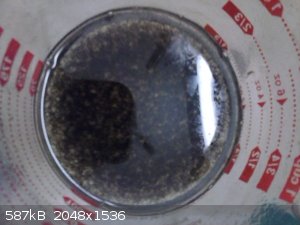
|
|
|
blogfast25
International Hazard
    
Posts: 10562
Registered: 3-2-2008
Location: Neverland
Member Is Offline
Mood: No Mood
|
|
Quote: Originally posted by bigtrevs98  |
Oh and another quick question. In experimenting with the clear top-layer (smells like acetone on steroids and has a blue color to it) I mixed some of
that with household bleach and the solution precipitated black/brown specks that floated on top and eventually settled to the bottom and seemed to
harden a bit.. I know mixing bleach and acetone make chloroform. But I think the brown/black specks may have been dissolved by the chloroform because
isn't chloroform. Solvent? But original question was what are the specks? (I'll upload pictures in a couple minutes
|
You really shouldn't be mixing stuff just willy-nilly, you know?
Chloroform is a solvent but it doesn't form that easily in your conditions. It's also not a solvent for ionic compounds like Cu(II) acetate.
If there was any heat involved, the black specs were probably partly dehydrated copper hydroxide. Bleach is quite alkaline and precipitates Cu(OH)2
from Cu(II) salt solutions.
|
|
|
bigtrevs98
Harmless

Posts: 35
Registered: 14-4-2015
Member Is Offline
Mood: No Mood
|
|
Yeah I know blogfast. Its not really a good idea. I usually do things in very small pre portions first. (Couple drops) I've only partially been
through a chemistry class but I know the safety precautions. I do most of my experiments outside too. I just do things with some knowledge I usually
try to find out as much info as I can first also. Like I know not to mix H2O2 and acetone unless I actually know what exactly I'm doing first. I'm
hoping to start college in next few months. But I try to just learn and expand my mind with the small am mount of supplies I have available at the
moment.
[Edited on 4-5-2015 by bigtrevs98]
|
|
|